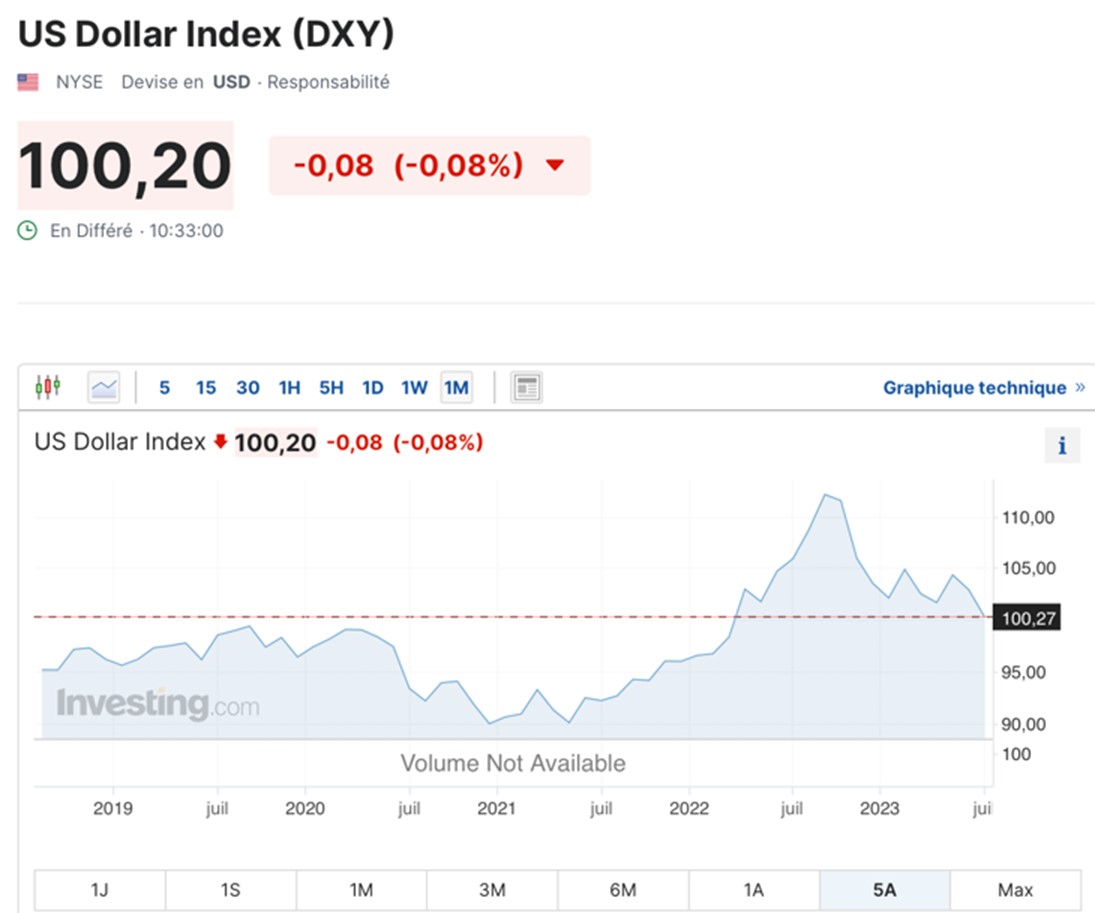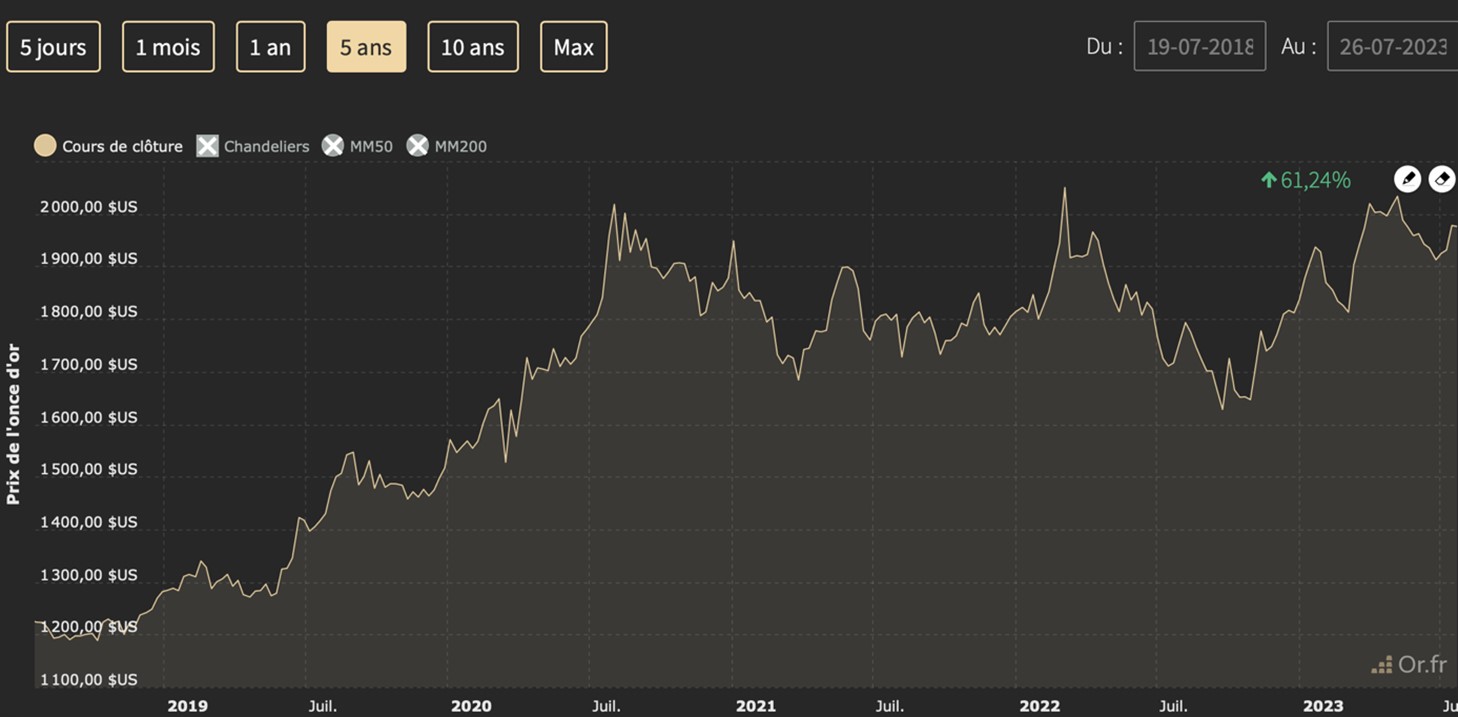The close relationship between gold and the dollar is well known: when the greenback rises, the yellow metal falls. For several years now, however, the international context has been shaking things up. Rampant inflation, financial instability, deglobalization, geopolitical tensions, the international economic slowdown, the slow de-dollarization of the world, and other major contemporary issues have led to a keen interest in gold. This demand seems even to be resisting, in the long term, when the dollar rate rises.
From mid-2021 onwards, when the Fed began to raise interest rates (a move not seen since 2018), the US currency rose continuously. Rising real yields on US Treasuries have generated increased demand, which benefits the dollar.
On the other hand, the international context has led to a "flight towards quality." Investors are selling their risky assets to buy safer ones, primarily US Treasuries.
Thus, despite the sale of US bonds by many countries (either to de-dollarize, or to appreciate their currencies and limit inflation), the dollar has appreciated over the past year in comparison with the main international currencies. Between May 2021 and October 2022, the DXY rose from 90 to 110. This index measures the evolution of the dollar against a basket of six currencies (primarily the euro, but also the yen, Swiss franc, Canadian dollar, pound sterling and Swedish krona) selected according to their relative importance in US foreign trade. The dollar also reached an all-time high, its highest level in twenty years. It also reached parity with the euro for a time.

Dollar exchange rate, DXY index
Gold more resilient than ever
Mechanically, gold was supposed to fall over the same period, since its price generally moves inversely to the greenback. This time, however, this was not the case. Investors sought protection against inflation, which began in April 2021. The price of the yellow metal only retreated after the war in Ukraine, in February 2022, and then for a few months when the dollar peaked. The freezing of Russian assets then prompted central banks to massively increase their gold reserves in order to hold an asset that does not depend on the authority of any power. And growing geopolitical tensions, notably between China and Taiwan, accelerated this phenomenon. Driven by massive purchases by monetary institutions and investors worldwide, the price of gold reached a peak of over $2,000 an ounce last May.

Gold prices, website Goldbroker.com
The dollar's rise was only temporary
Since the end of 2022, the dollar has lost almost 10% and its value continues to fall. Several months ago, the markets were already expecting the Fed to be less aggressive in its monetary policy, or even to take a pause in raising interest rates. This scenario was confirmed last June, when the US central bank announced that it would not be raising interest rates in the coming weeks, before planning two further hikes between now and the end of 2023. As a result, the dollar has fallen steadily in recent months.
In addition, the United States has simultaneously recorded a public deficit (spending exceeds revenue) and a current account deficit (the value of imports exceeds that of exports). This is further dragging down the US currency.
These deficits are just as large as during the 2008 crisis.
Outside the U.S., the dollar's decline is positive in several respects:
-
The majority (nearly 90%) of commodity prices, particularly energy and wheat, are denominated in dollars. A fall in the dollar therefore means, by extension, a fall in prices. All the more so as the effects of the war in Ukraine and speculation have eased, leading to a slowdown in inflation. However, underlying inflation, which excludes food and energy prices, remains "sticky", i.e. entrenched, in many countries.
-
The cost of debt for dollar-indebted countries can vary according to the greenback's rise. A depreciation of the dollar therefore leads to a reduction in the amount of interest on debt. But the U.S. currency remains high, and the Fed's numerous rate hikes will sharply increase the cost of servicing their debt in the medium and long term (leading to fears of a debt crisis in certain countries, as happened in the 1980s in Latin American and African countries following the "Volcker shock").
-
The reduction in the cost of products expressed in dollars favors importing companies, particularly SMEs (more than half the world's imports are paid for in dollars). And in more ways than one, since the price of container shipping has fallen in recent months after a sharp rise between 2021 and 2022 (some companies have been able to negotiate a reduction in rates, but very few have escaped the dollar to pay in another currency - currency hedging represents a non-negligible cost).
-
Last but not least, gold continued its upward trend. The yellow metal experienced a sharp rise last March, when the Fed intervened on a massive scale to support the American and international banking and financial systems. The Fed's decision last June to pause its rate hike was another bullish factor for gold.
While the US currency remains relatively strong, the downward trend it has been following for several months is set to continue. The economic slowdown in the USA (a recession is highly likely by the end of 2023) and monetary tightening by other central banks are factors pulling the dollar down. The ECB, in particular, is likely to continue raising interest rates, and to be more aggressive than the Fed due to entrenched inflation. Even so, the Fed's next two rate hikes will give the greenback some resilience.
Ultimately, little movement is to be expected in the short term, but the dollar will lose more ground in the medium term. Finally, from a long-term perspective, the US currency will inevitably decline as the world gradually de-dollarizes. The Fed will then be forced to keep real interest rates high, which will weigh on the cost of debt. In fact, the cost of debt now exceeds the budget allocated to the defense sector (a particularly important expense in the country). Interest on the debt will reach $1 trillion next quarter, compared with around $800 billion for defense.
This situation can only get worse, as one US federal agency estimates in what is, all in all, an optimistic scenario: "Debt will rise relative to GDP, reaching 181% of GDP by 2053. Such high and rising debt would slow economic growth, push up interest payments to foreign holders of U.S. debt, and pose significant risks to fiscal and economic outlook."
Beyond these projections, it is important to note that fewer and fewer foreign countries are financing the US external deficit through purchases of Treasury bonds. This de-dollarization movement is particularly prevalent in the Global South and the BRICS. But also, without any real desire to move away from the US currency, in Japan. For several months now, the governor of the Japanese central bank has been selling US bonds to support the yen. For their part, European countries, long-time buyers of Treasuries, will be marked for a long time to come by the effects of the health crisis and the war in Ukraine (Europe's trade balance still showed a deficit in May). Finally, with inflation and rising interest rates leading to asset depreciation, and hence unrealized capital losses, the Fed can no longer monetize US debt as it used to. The government will therefore have to make some tough choices. And time is of the essence, as US public debt continues to grow: it has soared by $2 trillion - more than Spain's total debt - in the space of just a few weeks).
It has always been essential to follow the evolution of the dollar in order to understand the evolution of gold. In an article written over a year ago, we indicated that the acceleration of de-dollarization would lead to an increase in demand for gold. This scenario remains as valid as ever. But it would also seem that the appeal of physical gold is becoming less and less dependent on the evolution of the dollar. With so many issues now facing the world, international investors are looking for an asset they can trust, and above all, protection against the continuing loss of value of currencies.
Gold remains illuminated for a long time to come...
Reproduction, in whole or in part, is authorized as long as it includes all the text hyperlinks and a link back to the original source.
The information contained in this article is for information purposes only and does not constitute investment advice or a recommendation to buy or sell.

















